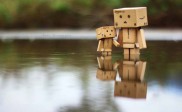Spice Up Your Shots with Unusual Camera Angles
We usually take pictures at eye-level, which would be a few feet higher than the ground. The captured scene may seem common and familiar, since this angle is how we normally view the world. Simply changing the camera angle in relation to the subject can introduce a different impression, and can make a world of difference in the impact of our shots.
The act of changing the camera angle to something other than eye-level can be as easy as lying low on the ground or climbing up a flight of steps. However, an unusual camera angle can imply various meanings that affect how a viewer interprets the shot. It also has a direct effect on compositional perspective.
Low Camera Angle
When shooting lower than eye-level, everything seems larger in size. The viewpoint seems to be coming from someone small in stature. You can use a low camera angle in many ways.
- Keeping the camera facing forward while at a low angle can show how small living subjects, such as pets and children, would view the world. They can also be the subject of your composition and is a great way of capturing them in a more relaxed and appealing body stance. They won’t have to tilt their head back to look up at your camera.

Photo by Publicenergy
- A low angle with the lens tilted upwards can exaggerate the scale and size of the subject. Perspective can make objects seem larger than they actually are, and they might appear superior and powerful as they loom over the lens.

Photo by Aigeanta
- A low angle composition is effective in adding interest to an ordinary scene. A photo of a grassy field taken at eye-level might look ordinary, but if shot from a low angle, it offers a new way of looking at the same scene.

Photo by J Anand
- Sometimes, a subject can be surrounded by distracting elements which cannot be physically removed from the scene. Going low and tilting the camera up is a good trick to keep the subject in the shot while keeping those distractions off the frame.
High Camera Angle
Shooting higher than eye-level gives the opposite impression compared to a low angle shot. The photographer appears to be very tall, while everything around is smaller or shorter than normal. Using a high camera angle also has its benefits:
- This elevated angle is great for group shots where you want everyone to be included in the frame. By using a stepping stool, walking up a flight of stairs, or shooting from a second-storey window, you can capture everyone’s faces without some heads blocking the others, which would otherwise be the case in the usual eye-level angle.

Photo by CarbonNYC
- Subjects taken from a high camera angle can appear smaller, and this can be used to convey the impression of insignificance or weakness. This illusion of shrunken size is even more dramatic when the subject is known to be large. From a high angle, houses, boats, and cars can look like toys, and people may look like Lilliputians.

Photo by Emilio Labrador
- As with all unusual camera angles, a high-angled shot can provide a fresh take on an ordinary scene.
- A high camera angle can also get rid of distracting elements so you can focus entirely on the subject.
- An extreme high camera angle is the bird’s eye view. As the term suggests, the viewpoint is as if it is coming from a bird flying high up in the air. Aerial shots of landscapes are perfect examples of this camera angle. You can also get these kinds of shots from atop a tall building and shooting downwards at the ground-level, or if you are on top of a mountain with the scenery down below.
Check out this view from the Empire State Building!

Photo by Wwarby
- Another type of high angle view is the top view or overhead view. It is similar to the bird’s eye view in that the camera is above the subject and facing downwards, but it is not as great in height.

Photo by Jsome1
Tilted Camera Angle
If you want to create a dynamic shot that has an off-kilter and wacky effect, try slanting your camera a little to its side so that the horizon appears diagonal in the frame. If done right, this tilted effect can add visual interest to your picture. Remember that not all scenes or subjects will look attractive with slanted camera angles, so choose your subject wisely.

Photo by Angelocesare




If you like this article, check out the article I wrote about flip-out screens and how they can help you find new angles: http://blog.warehouseexpress.com/the-lowdowns-and-high-ups-of-flip-out-screens/
flower ones works.. not sure about the cat…